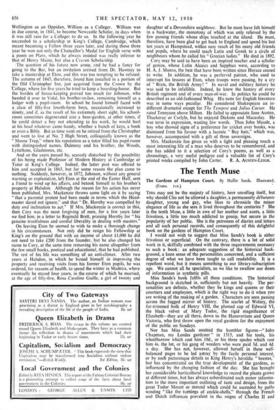The Tenth Muse -
The Gardens of Hampton Court. By Mollie Sands. Illustrated. (Evans. 2 I S.) THIS may not be the majesty of history, here unrolling itself, but why should Clio not be allowed a daughter, a permanently debutante daughter, young and gay, who likes to chronicle the minor elegance of life as she sees it lived throughout the centuries ? She is the tenth Muse, a little in awe of her mother and aunts, a little frivolous, a little too much addicted to gossip, but secure in the popularity of her public. She is the patroness of diaries and letters and all such personal records, and consequently of this delightful book on the gardens of Hampton Court.
I would not wish to suggest that Miss Sands's book is either frivolous or superficial. On the contrary, there is a lot of solid work in it, skilfully combined with the three requirements necessary to such a book: an adequate suggestion of the historical back- ground, a keen sense of the personalities concerned, and a sufficient degree of what we have been taught to call readability. It is a repellent word, but it means something to our library-subscription age. We cannot all be specialists, so we like to swallow our doses of information in synthetic pills.
Miss Sands's book fulfils all these conditions. The historical background is sketched in, sufficiently but not heavily. The per- sonalities are definite, whether they be kings and queens or their courtiers and employees, which is the right way to do it when you are writing of the making of a garden. Characters are seen passing across the fogged mirror of history. The scarlet of Wolsey, the fur-trimmed bulk of Henry VIII, the plumed cap of Edward VI, the black velvet of Mary Tudor, the rigid magnificence of Elizabeth—they are all there, down to the Hanoverians and Queen Victoria, who first threw open the royal gardens for the enjoyment of the public on Sundays. Nor has Miss Sands omitted the humbler figures—" John Chapman, my Lordes gardyner " in 1515, and his tools, his wheelbarrow which cost him 10d., or his three spades which cost him 4s. the lot, or his gang of weeders who were paid 3d. and 4d. a day. She has - not, however, allowed herself in these well- balanced pages to be led astray by the facile personal interest, or by such picturetque details as King Henry's heraldic " beestes," but has concentrated on the true developmeht of the gardens, as influenced by the changing fashion of the day. She has *brought her considerable horticultural knowledge to record the plants grown at different times, but has always subordinated such minor informa- tion to the more important outlining of taste and design, from the great Tudor Mount or mound which could be ascended, by paths winding " like the tutittings of cockle-shells," through the French and Dutch influences prevalent in the reigns of Charles H and William and Mary, to the present day when flowering shrubs un- known to our ancestors grow in the Wilderness, and the Troy Town of William III has become a rock-garden known as The Glen.
Today it is not on Sundays only that the gardens are open to the public, but daily, and many a Londoner would be well-advised to travel to Hampton Court with this book in his hand. It will add enormously to his enjoyment and interest. I have only one grievance, a serious one ; there is no index.
V. SACKVILLE-WEST.







































 Previous page
Previous page